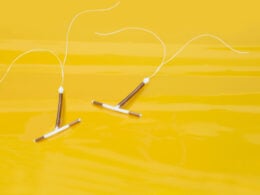In August, a Cosmopolitan article came across my newsfeed several times, titled “Here’s *Exactly* How Birth Control Works.” In it, readers are greeted by an ad for a new birth-control pill. Readers are then offered a breakdown of eight different birth control methods explaining how they work—except, not really.
Sure, at a rudimentary level, yes, the description of each method has some accurate information. But early on it becomes clear Cosmo is promoting these methods by focusing only on effectiveness at preventing pregnancy—not the full extent of how they work in terms of what they do to your body and overall health. For instance, Cosmo states, “birth control pills are also over 99 percent effective, but you have to use them according to your doc’s direction, otherwise they’re closer to 91 percent effective.” Written this way, it suggests the Pill is almost 100% effective, despite how for more women the low typical use rate (91%) is more realistic.
Since the article fails to mention what exactly are the long-term consequences and what each of these methods do to a woman’s health, safety, and hormones, I’ve supplemented Cosmopolitan’s lackluster list, because, know you, as they put it these days . . . Science.
The Non-Hormonal IUD
The copper IUD has been touted as being a natural and healthier option for women because it is hormone-free. Instead, “the copper IUD creates an inflammatory environment in your uterus that prevents implantation.” Cosmo reports that once implanted women may not have to give it a second thought for a good ten years and it is 99 percent effective. However, as Kathleen Taylor once wrote for Natural Womanhood, “Among the commonly understood side effects of the IUD are heavier, longer, more painful periods at first which may take up to a year to regulate. Other side effects include pelvic inflammatory disease, backache, pain during sex, and the device may become stuck in the uterus or move through the wall of the uterus causing infection, scarring, or damage to other organs.” While this may be called a “set it and forget it” method of birth control, it’s unlikely women experiencing side effects from the copper IUD will forget they have it.
Furthermore, the IUD can cause copper toxicity and an imbalance of copper can sabotage thyroid function, which is directly responsible for regulating reproductive hormones. As Taylor said, while the copper IUD is presented as a natural, hormone free-way for women to regulate their bodies, “using it creates a risk of damaging the part of the body that regulates our natural hormones!”
The Hormonal IUD
Like the copper IUD, the hormonal IUD is another iteration of the “set it and forget it” form of birth control. The major difference, however, is the hormonal IUD, as indicated by its name, once in place it releases a steady stream of hormones into a woman’s body. As Cosmo reports:
They work by releasing a synthetic hormone called progestin that thickens your cervical mucus, more or less making it impenetrable, thereby preventing pregnancy, explains David Ryley, M.D. a reproductive endocrinologist at Boston IVF (read: no sperm getting through here!). Progestin also thins the lining of the uterus and could stop your body from ovulating (AKA releasing an egg), he says. And if you don’t ovulate? Well, then it’s pretty tough to get pregnant.
All true, except this description fails to mention a few key issues. First, the Cosmo description suggests ovulation does not occur, so that no egg is released. But IUDs can allow ovulation, along with the fertilization of the sperm and egg; when this happens, the thinned uterine lining provides a hostile environment for a fertilized egg, keeping it from implanting in the uterus, resulting in the loss of the fertilized egg.
Further, around 10 percent of all IUDs are malpositioned, which can lead to a wide array of side effects ranging from unpleasant to downright life-altering. “Symptoms of a displaced IUD, such as new or especially bothersome cramping, heavy menstrual bleeding, or bleeding or spotting between periods.” A malpositioned IUD can increase risk of pregnancy, and for women who do conceive with the IUD in place, “the miscarriage rate is approximately 50 percent.” Furthermore, the IUD can perforate the uterus, which although rare, can cause long-term complications.
Combined Oral Contraceptives
The combined oral contraceptive integrates “synthetic versions of both progestin and estrogen in order to prevent the release of two other hormones (follicle-stimulating hormone and luteinizing hormone) that cause ovulation.” Cosmo explains that this process stops ovaries from releasing eggs, thins the uterine lining, thickens cervical mucus—everything needed to prevent the egg from being fertilized or the embryo implanting and preventing the occurrence of pregnancy.
However, synthetic changes to one’s hormones are not part of the body’s natural function, so it should be no surprise that women often experience changes to their health in other ways. Not only are oral contraceptives associated with physical and mental health side effects, many women report they generally feel less like themselves on oral contraceptives. “When combined, they can manipulate more aspects of the feminine cycle, and can thus be more effective at preventing pregnancy. They also cause more side effects, from blood clots to depression. Combination therapy is also used to manage hormone levels during menopause. But at what cost?” writes Lindsay Schlegel for Natural Womanhood.
While we need hormones for our health, Natural Womanhood CEO Gerard Migeon explains, “the artificial ones are different in shape, potency and metabolism, which does harm to the human body, some immediately visible (side effects), some less easy to perceive but that may be even more damaging.”
Despite these issues, the current recommendation by many doctors is to prescribe such birth control in bulk, limiting doctors’ ability to check in with patients’ health.
The Progestin-Only Pill
Progestin is a term for drugs and hormones similar to the hormone progesterone, and it is found in the “mini-pill,” considered a less effective version of the combined pill. As Cosmo explains: “In this case, progestin thickens up your cervical mucus, again, to prevent sperm from swimming up the uterus.” Cosmo then admits the progestin-only pill may not always succeed in suppressing ovulation, but it nonetheless encourages the reader to take it every day to be effective.
However, as we’ve noted at Natural Womanhood, “Progestin can cause headaches, fluid retention, and weight gain, and may also increase the risk of developing breast cancer and cardiovascular disease,” not to mention increased risk of osteoporosis and bone fractures, too. In 2012, The Atlantic reported that because progestin primarily targets the brain, it is meant to basically shut off production of progesterone. Because progesterone receptors can be found in abundance in the brain, progestin can have effects on the central nervous system beyond reproductive function, and while some are positive, it can make the brain more vulnerable to degeneration. However, as also reported by The Atlantic:
In contrast to the abundance of studies on the effect of estrogen and progestin therapy on cognition, the exact effects of progestins by themselves remain elusive. The Women’s Health Initiative Memory Study (WHIMS), the largest randomized, controlled study of the kind, found that a group of women treated with conjugated equine estrogen and metroxyprogesterone (one form of progestin) had higher risk of probable, all-cause dementia compared to women who took only estrogen or placebo.
The Hormonal Vaginal Contraceptive Ring
The contraceptive ring is somewhere between the IUD and combined oral contraceptives. It contains both estrogen and progestin, but it is placed in the vagina and left there to release a steady stream of hormones.
Several years ago, we wrote about the tragic death of Erika Langhart, who died from a pulmonary embolism as a result of the Nuvaring. According to the National Blood Clot Alliance, most hormonal contraceptives increase a women’s risk of blood clots, however, there are some that increase this risk more than others, including the vaginal ring. Langhart is not the only one who has been taken to soon by tragic and preventable side effects caused by hormonal birth control.
The Birth Control Shot
The shot contains progestin, only in a higher dosage than the mini-pill which according to Cosmopolitan makes it more effective at preventing pregnancy. But there are significant risks associated with the birth-control shot, such as the early onset of osteoporosis and osteoporotic bone fractures, even among young women. Perhaps most alarmingly, the birth-control shot Depo-Provera has been found to increase women’s risk of contracting HIV.
While data is mixed about the link between weight gain and birth control, it’s been documented that some woman will experience weight gain and water retention from hormonal contraception, especially if they get the Depo-Provera shot. In fact, a 2009 study published in the American Journal of Obstetrics and Gynecology found that “bodyweight and fat significantly increase with the use of [Depo-Provera].”
As Zahra Barnes wrote for Self,
Keep in mind they’re talking about statistic significance, not real-life significance. Alyssa Dweck, M.D. notes that “Depo-Provera is known to cause weight gain for a lot of women,” but she advises patients that it should only be two to five extra pounds. “If you’re putting on 30 pounds after you get Depo, it’s not from Depo—it’s either some other health irregularity with your hormones or your thyroid, or it’s diet and exercise.”
Dweck’s assessment may be true, but if these health irregularities didn’t rear their ugly heads until after a woman was prescribed Depo-Provera shots isn’t it safe to assume that they are somehow related?
The Implant
“This thin rod about the size of a matchstick goes under the skin of your upper arm and, like the shot, it contains a hefty dose of progestin that’s released over the course of three years,” said Dr. Brian Levine for Cosmopolitan. As Cassie Shortsleeve writes for Cosmo, “you also can’t personally mess this one up—it’s in your arm!” However, it’s not that simple, as it’s been well-documented that many things can go wrong.
The implant has a history of migrating from its implantation point, which makes retrieval difficult, and sometimes impossible, thus extending the effects of the implant long after it’s supposed to be out of a woman’s body.
“Difficulties with insertion, migration, and retrieval aside (which, by the way, are also rare but serious issues shared by the other popular LARC, the IUD), Nexplanon also comes with the host of birth-control side effects that come with any form of hormonal contraception, such as the Pill. The most common side effects range from loss of libido and mood changes to migraines and blood clots”.
The Patch
The Patch acts like the vaginal ring, only its placed topically on the skin, so at this point, it should be no surprise to you that it’s unsavory side effects are similar. Like its counterparts, the patch is often used to “patch up” side effects of being a woman—acne, painful periods, irregular cycles, etc. However, as Cassondra Moriarty wrote for Natural Womanhood, “the pill (and patch and ring, etc.) may be great for managing your symptoms. But when it comes to treating them—well, it doesn’t. If you want to address these symptoms at their root, your best bet is to find a medical protocol that uses fertility charting to regulate hormones.”
Natural Birth Control Methods
Luckily, there is a natural, body-positive and health-friendly method of natural family planning available that does not compromise a woman’s natural hormones, lead to physical harm, and does require a woman to choose between her health and well-being and pregnancy prevention. Fertility awareness methods (FAM), also known as natural family planning (NFP), allow a woman to take charge of her fertility simply by observing her biomarkers. Furthermore, FAM promotes gender equity and shared family planning responsibility between sexes, which can, in turn, strengthen a couple’s intimate and emotional relationship.
Unfortunately, this isn’t the first time Cosmo has left facts out of its coverage on reproductive health. While the concept of many hormonal contraceptives may look appealing and practical on paper, it’s worth learning about the long term effects of how they *really* work, in order to make the most informed choices.
When this article refers to fertility awareness methods (FAM), or natural family planning (NFP), we are referring to Fertility Awareness-Based Methods, evidence-based methods of cycle charting which can be used as effective forms of natural birth control when learned by a certified instructor.











